#Catholic pilgrimage tours
Text

Are you looking for Catholic pilgrimage tours ? Christopher Cross, KHS provides Catholic tours and pilgrimages, Jerusalem Tour. To get more visit www.catholicholyland.com .
#Holy Land Tour#Holyland Pilgrimage#Catholic Tours#Catholic Jerusalem Tour#Catholic tour company#Catholic pilgrimage tours#Catholic tours and travels#Best catholic pilgrimages
0 notes
Text
.
#im crying we'll be travelling across Europe as a family but it's a pilgrimage tour thing#we will be having catholic mass every day 😭😭😭😭😭#i am a practicing catholic but pls..........
2 notes
·
View notes
Text
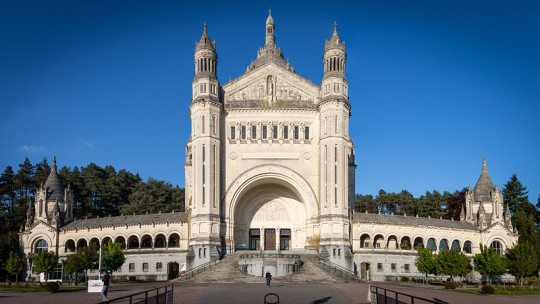
Basilique Sainte-Thérèse de Lisieux
Canon EOS R / 24-105mm F4 DG OS HSM Art
24.0 mm / ƒ/8.0 / 1/200 / ISO : 100
3 photos (portrait mode) stitched
Visite de la Basilique Sainte Thérèse de Lisieux
in English below
La Basilique Sainte-Thérèse de Lisieux est un édifice religieux catholique situé à Lisieux, dans le département du Calvados, en Normandie (France). Elle est dédiée à Sainte Thérèse de Lisieux, une religieuse française canonisée en 1925.
La basilique a été construite entre 1929 et 1954, dans un style romano-byzantin, et mesure 107 mètres de long et 35 mètres de large. Elle est considérée comme l’une des plus grandes églises catholiques du XXe siècle.
La basilique abrite le tombeau de Sainte Thérèse de Lisieux, qui y est enterrée depuis 1925. Elle est également le centre de pèlerinage de la ville de Lisieux, qui attire chaque année plus de 150 000 pèlerins. Les visiteurs peuvent accéder au dôme de la basilique, qui offre une vue panoramique sur la ville de Lisieux et la campagne environnante. La basilique abrite également un musée consacré à la vie de Sainte Thérèse, ainsi qu’un cinéma qui diffuse un film sur sa vie.
Les visiteurs peuvent également visiter la crypte de la basilique, qui est décorée de mosaïques représentant la vie de Sainte Thérèse. La crypte est également le lieu de repos de plusieurs religieux et religieuses de l’ordre carmélite.
Pour monter jusqu'en haut il nous a fallu monter 500 marches nous a-t'on dit... Je ne les ai pas compté personnellement mais mes jambes s'en sont rappelé toute la nuit...
Visit to the Basilica of Saint Thérèse of Lisieux
The Basilica of Sainte-Thérèse de Lisieux is a Catholic religious building located in Lisieux, in the Calvados department, in Normandy (France). It is dedicated to Saint Thérèse of Lisieux, a French nun canonized in 1925.
The basilica was built between 1929 and 1954, in a Roman-Byzantine style, and measures 107 meters long and 35 meters wide. It is considered one of the largest Catholic churches of the 20th century.
The basilica houses the tomb of Saint Thérèse of Lisieux, who has been buried there since 1925. It is also the pilgrimage center of the city of Lisieux, which attracts more than 150,000 pilgrims each year. Visitors can access the dome of the basilica, which offers panoramic views of the city of Lisieux and the surrounding countryside. The basilica also houses a museum dedicated to the life of Saint Thérèse, as well as a cinema which shows a film about her life.
Visitors can also tour the basilica's crypt, which is decorated with mosaics depicting the life of Saint Teresa. The crypt is also the resting place of several monks and nuns of the Carmelite order.
To get to the top we had to climb 500 steps, we were told… I didn't count them personally but my legs remembered them all night…
Photo : Frédéric Poirier
#photographers on tumblr#flickr#original photographers#outdoor#canon eos r#sigma lens#sigma 24-105mm f/4 dg os hsm art#basilica#basilique#st therese of lisieux
21 notes
·
View notes
Text

St. Yves’ Day Special: The Ankou
~ ~
Our third Celtic Month piece celebrates St. Yves’ Day, the national day of Brittany; which is on May 19th. Remember to sing some Breton folk songs.
Before you read what the piece means to me, share what it means to _you_. I’m just the artist; you’re the beholder.
Leave a comment.
~ ~
The Bretons dwell in Brittany, a peninsula of France; and both the people and their homeland derive their name from their origin as Britons who fled from Britain to the mainland during the Anglo-Saxon invasion. They are the only Celts who live in mainland Europe, at present; but they came from the Isles. The Breton language is closely related to Welsh and even more closely related to Cornish.
In Breton folklore, the Ankou is said to be an assistant to Death; a figure in a black cloak and hat who collects the souls of the dead and guides them into the afterlife.
Many tales are told about his origins. Some say he was the first child of Adam and Eve, and the first human being to die. Others say he was a prince who challenged Death, and lost.
Others say, and this is the notion I prefer, that the Ankou is the last, or first, person to die in each parish each year; responsible for guiding souls for one year until another takes their place. That way, the dead are greeted by a familiar personage when it’s time to make their final journey.
There are equivalent legends in Cornwall and Wales; the Cornish term is Ankow, and the Welsh term is Angau. There are comparable legends elsewhere. According to a Scottish legend, the last person buried in a graveyard is responsible for guarding it until the next burial. In parts of England there are legends that the first person buried in a graveyard will be responsible for guarding it; and customarily, a dog is buried first, to become the graveyard’s church-grim (a well and truly good boy).
The soldier in the grave, whose soul is being beckoned by the Ankou, as well as the priest performing the funeral liturgy, are a homage to one of my favorite Breton folk songs, Ar Soudarded (Zo Gwisket e Ruz). The chorus-verse means “The soldiers dress in red; the priests dress in black.” It’s a melancholy song about a soldier who speaks of his burial if he should die.
I chose to depict the dead spectres in monochrome; and I’m not sure it was an effective choice. I found it necessary to add the luminous peach-colored halos to clarify the intended effect.
The steeple in the background is inspired by the distinctive cutout designs in the steeple of Tréguier Cathedral.
St. Yves of Kermartin, also called St. Yves Hélory, whose name is also spelled all sorts of other ways such as Ives, Ivo, Erwan, Iwan, Youenn, and Eozenn, and who is not to be confused with St. Yves of Chartres, St. Erbin of Dumnonia, or anyone with the surname Saint-Yves, was a pious clergyman and lawyer who was known for representing the poor and vulnerable, refusing bribes, and unraveling the tricks of swindlers. Every year on his feast day, May 19th, Catholic lawyers from around the world gather at his major shrine at Tréguier Cathedral to pay pilgrimage. Tréguier is also one of the seven sites of the Tour of Brittany, although not because of St. Yves.
The two women mourning at the burial are wearing distinctive traditional stovepipe bonnets, a notable feature of Breton dress.
#st_yves_day#st_yves#brittany#breton#treguier#ankou#death#celts#celtic#spring#springholidays#digitalart#vector#mosaic#collage#inkscape
7 notes
·
View notes
Text

📍Taal, batangas
The Basilica of Saint Martin de Tours is located in the town of Taal in Batangas, Philippines. Built in the 19th century, it is one of the largest catholic churches in Asia and is considered a masterpiece of Baroque architecture. The basilica is named after Saint Martin de Tours, who is known for his dedication to the poor and the sick. The church features intricate details such as its stunning altar, painted ceilings, and stained-glass windows. The basilica also houses various religious relics and artifacts, including a silver urn containing the remains of Saint Martin himself. It is a popular pilgrimage site for locals and tourists alike and holds a special place in the hearts of the Batangueños.
#wowpinas#philippines#exploringphilippines#adventurephilippines#comeseeph#seepilipinas#traversephilippines#chooseph#discoverph#grammerphilippines#igpilipinas#lostinph#mabuhayph#philippinesgram#pilipinasdestination#pinasmuna#pinaswonders#sinopinastraveler#tapphiph#the_ph#whenwithfilipinos#tuklas_pilipinas#taalbatangas#wheninbatangas#litratongpinoy#wanderlustph#itsmorefuninph#tumbler
23 notes
·
View notes
Text
The Pretty Cures and its Saints: Hirogaru Sky! Pretty Cure
In celebration of the franchise’s 20th anniversary, I have to share with you all with their birthday corresponding with feast days that is honored and recognized by the Roman Catholic Church!

September 20 - Sora Harewataru (Cure Sky)
St. Andrew Kim Taegon: 19th century Korean martyr who was first Korean-born Catholic priest. In the late 18th century, Roman Catholicism began to take root slowly in Korea, and was introduced by scholars who visited China and brought back Western books translated into Chinese. Born of yangban (a part of the traditional ruling class or gentry of dynastic Korea during the Joseon Dynasty), parents were converts and his father was subsequently martyred for practising Christianity, and after he baptized at 15, he studied at a seminary in Macau. Andrew also spent time in study at Lolomboy, Bocaue, Bulacan in the Philippines, where today he is also venerated. During his trip to Korea, Andrew is canonized as a saint by Pope St. John Paul II, along with 102 other Korean Martyrs, including Paul Chong Hasang on May 6, 1984.
July 16 - Mashiro Nijigaoka (Cure Prism)
Our Lady of Mount Carmel (Nuestra Señora del Carmen): A Marian title that is given to the Blessed Virgin Mary in her role as patroness of the Carmelite Order (Order of the Brothers of the Blessed Virgin Mary of Mount Carmel), particularly within the Catholic Church. The first Carmelites were Christian hermits living on Mount Carmel in the Holy Land during the late 12th and early to mid-13th century. They built in the midst of their hermitages a chapel which they dedicated to the Blessed Virgin, whom they conceived of in chivalric terms as the 'Lady of the place.' Since the 15th century, popular devotion to Our Lady of Mount Carmel has centered on the Scapular of Our Lady of Mount Carmel, also known as the Brown Scapular. Traditionally, Mary is said to have given the Scapular to an early Carmelite named Simon Stock, a prior general of the order in 1251. She is honored as the patron of Chile, as well as protection from harm, dangerous situations and Purgatory.
May 21 - Tsubasa Yuunagi (Cure Wing)
St. Helena of Constantinople: 4th century empress and is known as the mother of Emperor Constantine the Great, who is later a saint. Helena is honored as an important figure in the history of Christianity. In her final years, she made a religious tour of Syria Palaestina and Jerusalem, during which ancient tradition claims that she discovered the True Cross.
August 8 - Ageha Hijiri (Cure Butterfly)
St. Dominic de Guzmán: Spanish priest who is widely known as the founder of the Order of Preachers aka the Dominicans. According to one story, Dominic’s mother, Bl. Joan of Aza, made a pilgrimage to the Abbey at Silos, and dreamt that a dog leapt from her womb carrying a flaming torch in its mouth (it later becomes one of the saint’s attributes), and ’seemed to set the earth on fire.’ The spread of the Rosary, a Marian devotion, is attributed to Dominic’s teachings, and has it for centuries been at the heart of the Order. The Dominicans have been instrumental in spreading the rosary and emphasizing the Catholic belief in the power of the rosary for centuries. His major shrine can be found in Basilica of San Domenico in Bologna, and he is the patron of astronomers.
#random stuff#catholic#catholic saints#precure#pretty cure#hirogaru sky precure#sora harewataru#cure sky#mashiro nijigaoka#cure prism#tsubasa yuunagi#cure wing#ageha hijiri#cure butterfly
4 notes
·
View notes
Text
The Casavant Wish (and Dream) in the Cathedral-Basilica of St. Augustine
I describe the history of the Cathedral-Basilica of St. Augustine as a Three Little Pigs parallel.
The first structure of the church was built probably by wood in haste fashion. But in 1586, a pack of British “big bad wolves” - led by Sir Francis Drake - burned it and the colony of St. Augustine. The colonialists built a second church of palmetto and straw, but it also burned down in 1599.
And despite the construction of Castillo de San Marcos in 1672, the third church was also burned down 30 years later. Masses were held at the chapel of La Solidad Hospital till Florida ceded to the British in 1763.
In 1784, Catholicism returned to Florida when the British ceded it to Spain, which ordered a church to be erected 2 years later. The cathedral was erected in 1797. Though another fire consumed the cathedral on April 12, 1887 - that time caused by a fire at the St. Augustine Hotel (now Flagler College) - it was much more feasible to rebuild, as the coquina walls proved resiliency.
Pope Paul VI designated the cathedral as a minor basilica on December 4, 1976.

Taken on 3/25/2018.
Fast-forward nearly 25 years later, on August 2001. My first time going inside the cathedral was on a day-trip with DCs, DUs, DAs, and DPs. We attended part of Mass, but the organ music sounded convincing. I tried SO hard to pay attention to the homily, but parts of my mind were wondering if the organ was truly a pipe organ.
That got me to make one of my 3 wishes to have a church install a pipe organ in case the said organ accompanying the Mass was electric. Indeed, it was a Rodgers analog one - a 3-manual instrument installed around the time Pope Paul VI designated the cathedral a minor basilica.
"The pipe organ is the authentic organ sound,” Dominican Sister Patricia Eileen Consier, Ph.D., and the cathedral’s then-current music ministry director pretty much described the musical aspect of my pilgrimage, “The totally electronic organ tries to achieve the pipe organ sound. Many times, an electronic organ company will say to you, ‘It sounds just like a pipe organ, doesn’t it?’”
To my 11-year-old ears, it INDEED sounded convincing.
That was most likely why nevertheless, I wished for a real pipe organ that day of my first visit. Little did I know at the time that the parish was ALREADY raising funds for the 3-manual Casavant Opus 3821 installed that Palm Sunday of 2003.
Over a decade later, I had a strange dream of a church that resembled the Cathedral-Basilica of St. Augustine, in a city that was similar to St. Augustine. I didn’t point out in my dream journal that I was touring St. Augustine, but the city was situated on a rocky coast, with palm trees and Spanish colonial architecture.
The interior of the church was strikingly similar to the real-life cathedral. But instead of the wooden pews, it had folding chairs. The facade of the pipe organ was much more distinct compared to reality. It had trompette en chamade pipes that crowned each side of the pipes in the reredos.
After a short walk outside, I revisited the church, but I eyed another set of pipes in the loft, also having a trompette en chamade rank. I woke up before I even got to hear it sing a postlude.
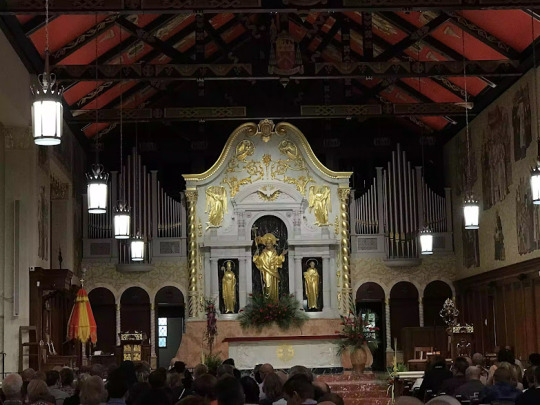
Also taken 3/25/2018.
It wasn’t till Palm Sunday 2018, 15 years after Casavant Freres granted me that wish, I attended another Mass at the cathedral, that time with the wish - which was expanded with the help of Walker Technical - sounding.
The newly-expanded Casavant Opus 3821 didn’t sound like that then-convincing-to-my-Catholic-tween-ears Rodgers analog I heard during the previous Mass a month before the Mournful Morning. (My memory was then fuzzy as the peaches in the peach-mango pies we brunched on with Chickenjoy at the Jax Jolibee a day later.) It was REALLY REAL.
And I sang the hymns with much more gusto than I sang visiting the church at age 11.
I visited it the third time on January 2020, shortly after disembarking the MS Harmony of the Seas. I’m glad to have DM’s college classmate and her adopted son tag us along for not only the cruise on the RCCL vessel as well as Universal Orlando, but also to have them give gratitude to God and to have me show them what I dreamed about in 2012.
I believed that at the time, when coronavirus had yet to hit the USA, one of their three wishes they made was for good health.
“(The Casavant Opus 3821) is the authenticity of Jesus,” Sister Patricia explained, “For example, there are real candles on the altar, not flash lights. The flowers are fresh. Our faith is the most authentic expression of our life. So, everything needs to be the real thing.”
At those visits in 2018 and 2020, the Casavant Opus 3821 sang at Mass Mike Batt’s lyrics:
Better than a dream
Stranger than my wild imagination
If this is a real sensation,
It's better than a dream.
And hearing the wish I made at 11 that Casavant Freres granted in 2003 - IN PERSON - was better than a dream.
#cathedral basilica of st augustine#st augustine fl#dream journal#pipe organ#casavant freres#casavant
2 notes
·
View notes
Text
May 27
Santiago de Compostela, the city that has been the destination of so many Catholic pilgrims over the centuries. According to legend, a ninth-century shepherd witnessed a moving star and followed it, the light eventually leading him to a burial site. The local bishop examined the bones found there and proclaimed them to be those of Jesus’ apostle, James, the patron saint of Spain. Hearing the news, the Spanish king ordered a cathedral be built on the spot in 1075. In doing so, he not only transformed Santiago de Compostela into one of the most sacred Catholic destinations in the world, but he also nurtured the budding relationship between the Spanish monarchy and the Catholic Church that would eventually come to dominate Spanish history and culture. Our walking tour was immersed in the history of James the disciple and brother of Jesus. Lunch included an experience of typical Galicia food including Octopus and Muscles! As pilgrims do we hiked the last three miles of the Camino de Santiago with others that had walked many miles on their own pilgrimage.










0 notes
Text
Week 8: Praha Midterm Season
Hello hello! This week’s Prague blog features mostly academic content, plus some margaritas to celebrate midterms being over and a weekend trip to London! As usual, feel free to jump to sections that are interesting to you. Enjoy!
Brady in Praha!
One of my closest guy friends from my hometown came to visit! We walked around the gardens and vineyard near our school and then grabbed dinner with two other guys from my high school that I wasn't as close with. It’s always nice to catch up with people you don’t normally talk to, we’ve all grown so much. We went to U Bulinu, a nearby Czech restaurant that was, to my surprise, really good! That is, despite a couple questionable menu items like “beef cheeks” and “rabbit head”. I played it safe and ordered the roast chicken, but one of the guys licked the plate of beef cheeks clean.
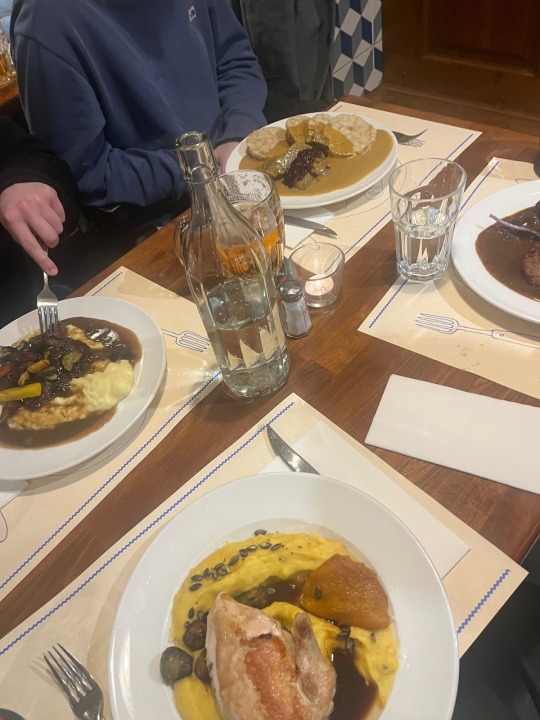
Architecture Tour
This week in architecture we visited Malá Strana, otherwise known as “lesser town”. Our tour was centered around the High Baroque architecture in the area, characterized by dynamic ornamentals, grandeur, and drama. Baroque arose from a competition between two Christian movements: the Catholic Church and the Protestant Reformation, with the Catholic Church initiating a counteraction to reaffirm its significance in society. Baroque evolved from Renaissance style and beauty, as artists introduced more extravagance and ornamentation into their work. High Baroque art and architecture, which flourished during the 17th century, features highly dynamic statues and ornaments that seem to move ‘in time’, contrary to the static or ‘above time’ appearance of the Renaissance style.
The first site we visited was the Church of Our Lady Victorious. Originally constructed in 1611 as a Protestant church, it was transformed into a Baroque-style church by the Catholics after they took control of Prague. The church’s most captivating feature is the "Golden Window," which frames the statue of the Infant Jesus of Prague. The gold symbolizes deity and sanctity, and the statue famously depicts God reincarnated as a baby. This profound image deeply resonated with devout Christians, turning the church into a popular pilgrimage site.
Next, we visited St. Nicholas Church in the center of Lesser Town Square, which stands at the site of a former Gothic church from the 13th century, also dedicated to Saint Nicholas, and before that, a small Romanesque rotunda. It is by far the most decorated church I have been to in Prague, and has been described as the greatest example of Prague Baroque. I’ve included a picture of the incredible interior below.
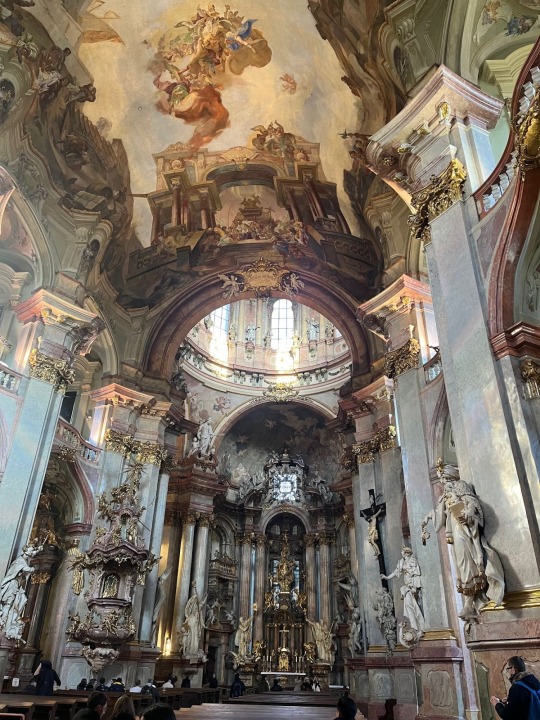
Malá Strana has also long been recognized for its aristocratic settlements. Today, the former noble Schoenborn Palace serves as the US embassy, illustrating the common practice of repurposing former palaces to house government ministries or embassies. Interestingly, Malá Strana also encapsulates a layer of Prague’s history during the communist era, when the KGB utilized an office within St. Nicholas Church to secretly monitor the nearby American embassy. This aspect adds a complex dimension to the church, juxtaposing its outward religious significance with the covert operations of the Soviet Union's secret police.
Cafe Louvre in Česky
We took a field trip with our Essential Czech class to Cafe Louvre to practice ordering in Czech. I’m the type to get anxious before ordering at any restaurant in English, so you bet I rehearsed the following sentence a couple times before the waiter came around to me. “Dam si avokadu chleb, prosim.” which means “I’ll have avocado toast, please.” He understood, but the toast came out a little weird since they boil their eggs before slicing and spreading them over the avocado mash. It tasted fine, so I’ll call it a success!
Alllll the presentations
This week I had way too many presentations. In architecture, my group presented on the architectural style of Vienna, which ended up being interesting due to the city’s historical significance as the Habsburg capital. During our Czech brunch, I also did a brief presentation on Milada Horakova, an incredible feminist, anti-Nazi, anti-Communist activist of her time. In Communications, we had to present on any topic, so my group chose UFOs and Area 51 and quickly compiled slides and graphics. And finally, in Databases, everytime we finish an exercise our professor spins a wheel which lands on one of the students in our class to present their work. This Thursday, I was the unlucky nominee. It called for a brief presentation of one of the database schemes we had to make and its associated SQL, so it could’ve been worse!
TEthics Midterm
The only real midterm exam I had was for my Tech, Ethics, and Public Policy class. I didn’t prepare too much since I’m in CoE so all of our grades transfer back as P/F, but I’m glad I’ve been participating in class because I’d already memorized most of the terminology just from paying attention.
The entirety of the exam was written. The first page had fill in the blank type questions, and the second two pages prompted a couple sentence responses. The final two pages were essay-type questions, with multiple prompts to choose from to write about. Overall, the exam went well considering the brief preparation I did for it.
Las Adelitas con Las Chicas
We found out that the Mexican restaurant near our apartment has discounted margaritas on Wednesdays for ladies, so obviously we had to hop on that. Mihika, Alisha, Lydia, and I booked a table for 4 to celebrate our midterms being over. We racked up 2 rounds of drinks before meeting a group of guys who were also American and studying in Prague. I jokingly offered to buy them drinks because the discount didn’t apply to them and they responded in sincerity, “can you actually?!” So we pulled up four chairs to our table and ordered another round! It was a gamble whether we would be charged full price for these since we *very visibly* passed them over to the guys, but the waitress was cool and gave us the discount anyway! Great service, insane tacos, and overall highly recommend to any girlies reading this.

London
This weekend I went to London and was blessed with amazing weather and blossoming flowers! I landed Thursday night and got horribly lost my first time on the London Underground trying to navigate between terminals to get to my hotel, and wound up a few stops beyond the airport. I was fed up with traveling for the day and called an Uber to bring me back. It was only slightly awkward when he asked where I was traveling to this weekend… “Uhhh, London” I said, defeatedly.

I delegated most of Friday to my walking tour of the city. I was staying right on Gloucester, so I was able to explore all of Westminster, including the Kensington gardens, Buckingham Palace, The London Eye, and Trafalgar Square (made famous to me by Mario Kart). The entire area smelled like fresh roses and lilac, it was such a gift. I also *had* to stop at Nandos afterwards and get some insane food! See views from my walking tour below, along with some good eats :)



Saturday, I met up with a friend studying there and explored Borough Market and Old London. We got the infamous chocolate covered strawberries at Borough (definitely lived up to the hype) and split a street food style sandwich doused in parmesan cheese. It was super crowded and hard to move through the market itself, but lines moved fast. Afterwards we walked along the water towards the old City of London, crossed the London Bridge, and then explored one of the oldest fortifications in Europe. Finally, we headed to Camden Market and Brick Lane to do a bit of shopping before dinner. These markets are known for thrifting, antiques, jewelry, and clothing as well as street food and drinks, which made it slightly more overwhelming than the Borough market for me, which was strictly food, but still enjoyable.
On Sunday we got delicious Dutch pancakes for brunch before saying farewell until the Summer. I had planned to visit the British Museum before my flight, but street protestors blocked entry so I pivoted and headed in the direction of Borough Market. I ended up wandering into a super cool Art exhibit. It was free too, what a pleasant surprise! Along the river I also saw a bunch of street performers, doing magic tricks, juggling, playing instruments, and more! It turned into a really nice day.
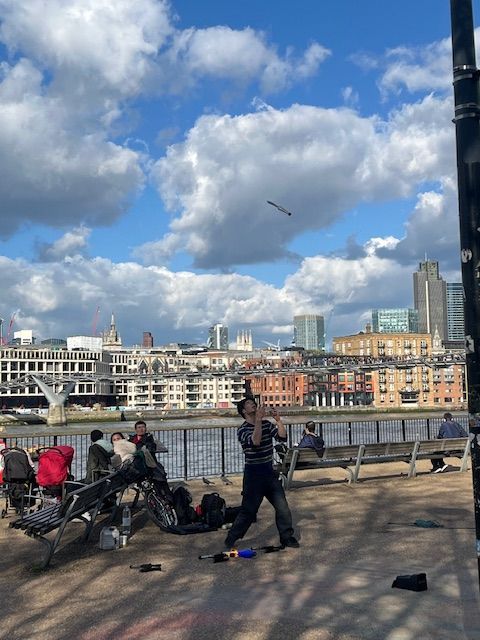
Ins:
Las Adelitas staff <3: Our waitress came in clutch and gave us the Ladies’ Night discount on the margaritas we ordered for our new guy friends. I said it before and I’ll say it again: great service, insane tacos, and overall, highly recommend to any girlies reading this who love margs!
London markets: All the food at Borough definitely lived up to the hype. The chocolate covered strawberries and the sandwiches in particular were to die for. Good vibes all around, attracting locals and tourists alike on the weekends!

Outs:
The first time trying a new public transport system: I swear I get so lost and confused every single time I enter a new city and try to take the metro for the first time. Traveling with another person makes a huge difference because you can try to talk it through and navigate with them, which is super helpful. Unfortunately I struggled alone this weekend. No tears though!
Keeping the cabin lights on throughout the entire flight: European airlines tend to keep the cabin lights on the whole flight, even when it’s nighttime and dark outside and people (like myself) would prefer to sleep. Tragic.
Thanks for keeping up with me! Have a good rest of your day :)
Na schle,
Reese Liebman
Computer Science and Engineering
Institute for Study Abroad (IFSA) CS Tech Career Accelerator in Prague, Czechia
0 notes
Text

SAINTS OF THE DAY FOR MAY 05
Bl. John Haile, 1535 A.D. Martyr of England, a companion in death of St. John Houghton at Tyburn. He was an elderly secular priest, the vicar of Isleworth, Middlesex, when he was arrested by King Henry VIII’s men. John was executed at Tyburn. He was beatified in 1886.
Bl. Sadoc & Companions, Roman Catholic Dominican missionaries and Martyrs. Sadoc was brought into the Dominican order by St. Dominic himself. Sent to Hungary with a group of Dominican missionaries, he labored among the Hungarians and then went on to Poland, where he founded and served as prior of a Dominican house at Sandomir, in 1260, however, the town was sacked by the advancing Mongols. Sadoc and forty-nine other friars were all put to death while singing the Salve Regina. Feastday May 5
Bl. Edmund Ignatius Rice, 1844 A.D. The founder of the Congregation of the Brothers of the Christian Schools often called the Irish Christian Brothers. Edmund was born in Wescourt, Ireland, in June, 1762, the fourth of seven sons in a fanning family at seventeen he began working at his uncle’s import-export business in Waterford. He later inherited the business. Married at twenty-five, Edmund lost his wife two years later and was left with a sickly infant daughter. A devout man, Edmund dedicated himself to charitable works. Though he saw how the economic and political storms of the day were impacting Ireland, he desired a religious vocation in the contemplative life. However, the Bishop of Waterford drew Edmund’s attention to the bands of ragged youth in the streets, asking Edmund if he, too, planned to abandon them. Encouraged by Pope Pius VII and Bishop Hussey, Edmund sold his business, arranged for his daughter’s care, and opened his first school in 1802.
St. Aventinus, 1180 A.D. Hermit and companion of St. Thomas Becket. A hermit in Tours, France, he was ordained a deacon by St. Thomas and accompanied him to the Synod of Tours in 1163. When Thomas was martyred In 1170 Aventinus went to Touraine, France, remaining there until his death.
St. Hydroc, 5th century. The patron saint of Lanhydroc Cornwall, England.
St. Echa, 767 A.D. Anglo-Saxon priest hermit, also called Etha. He was Benedictine who lived at Crayk, near York, England. Hermits such as Echa served as a link to the early Desert Fathers of Egypt.
S. NUNZIO SULPRIZIO, YOUNG WORKER OF NAPLES
St. Jutta, Widowed noblewoman of Thuringia, Germany, noted for visions and miracles. She married at fifteen and raised children. When her husband died on a pilgrimage to the Holy Land, Jutta moved to Prussia, becoming a recluse at Kulmsee. May 5
0 notes
Text
How to Plan Your Trip to Ephesus, Turkey
Ephesus, located in western Turkey, is one of the most well-preserved ancient cities in the world. It was a major Roman city during the classical period and is home to many historical and cultural sites, including the Temple of Artemis, one of the Seven Wonders of the Ancient World, and the Celsus Library, one of the most magnificent structures in ancient times.

Tourists visiting Ephesus can experience the rich history and culture of this ancient city through a variety of tours. The most popular tours include walking tours, guided tours, and private tours. Walking tours are self-guided tours that allow visitors to explore the city at their own pace. Guided tours are led by knowle dgeable tour guides who provide a wealth of information about the history and culture of Ephesus. Private tours, on the other hand, are tailored to the specific needs and preferences of the visitors and are often led by experienced guides.
The Temple of Artemis
One of the highlights of Ephesus Turkey tours is the Temple of Artemis, one of the Seven Wonders of the Ancient World. This magnificent temple was dedicated to the goddess Artemis and was considered one of the largest and most magnificent structures of the ancient world. Today, visitors can explore the ruins of the temple and get a glimpse of what it was like during its glory days.

The Celsus Library
Another popular attraction in Ephesus is the Celsus Library, one of the most magnificent structures of ancient times. The library was built in the 2nd century AD and was used to store and preserve manuscripts. Today, visitors can admire the stunning facade of the library and explore the ancient structure, learning about the history and culture of the city in the process.

The House of the Virgin Mary
The House of the Virgin Mary is also a popular attraction for tourists visiting Ephesus. This small house is believed to be the place where the Virgin Mary lived and died. The house has been a place of pilgrimage for Catholics for many centuries, and visitors can experience the peaceful atmosphere and spiritual significance of this historic site.

The City's Ancient Ruins
Ephesus Turkey tours also offer the opportunity to explore the city's ancient ruins and learn about its history. Visitors can explore the well-preserved Roman roads, aqueducts, and public baths, as well as visit the ancient theater, where gladiatorial contests and dramatic performances were once held.

The cultural sites
In addition to historical sites, Ephesus is also home to several cultural sites, including museums, art galleries, and local markets. Visitors can explore the Ephesus Archaeological Museum, which showcases a wealth of artifacts and historical treasures, or visit the local markets, where they can purchase traditional Turkish goods and souvenirs.
Ephesus Turkey tours are suitable for travelers of all ages and interests, whether you're a history buff, an art lover, or simply looking for a unique cultural experience. With its rich history and culture, stunning architecture, and beautiful natural scenery, Ephesus is the perfect destination for a memorable and enriching vacation.

Conclusion
Ephesus Turkey Tours offers a unique and unforgettable experience for travelers interested in history, culture, and archaeology. Whether you prefer to explore the city on your own, with a guide, or on a private tour, there's something for everyone in this magnificent ancient city. So, if you're planning a trip to Turkey, be sure to include a visit to Ephesus on your itinerary.
Resource : https://www.ask-aladdin.com/all-destinations/turkey/blog/how-to-plan-your-trip-to-ephesus-turkey
0 notes
Text

Are you looking for Catholic pilgrimage tours ? Christopher Cross, KHS provides Catholic tours and pilgrimages, Jerusalem Tour. To get more visit www.catholicholyland.com .
#catholic travel center#best catholic pilgrimages#custom tour of the holy land#catholic tour provider#catholic tours and pilgrimages#catholic tours and travels#catholic tour company#holy land tour#catholic holy land tours#catholic pilgrimage tours
0 notes
Text
Visit to Coimbra and then Fatima enroute to Lisbon - 12 September 2023
We left the riverboat and travelled to Lisbon with two stops enroute. We visited the ancient city of Coimbra. We were taken on the tour of the university established in 1308. This is part of the main university courtyard:

The buildings were very attractive:

This is another photograph of the buildings in the main courtyard with a statue of King Joao III.

We were taken for a tour of the Joanine Library founded in 1717. Here was a part we were allowed to photograph:

We visited the beautiful San Miguel Chapel within the university:

We were also shown inside the university buildings and this is the Grand Examination Room:

And here is another ancient room with ornate ceiling and paintings of monks and scholars of the past:

Just outside the university we saw a Roman aqueduct:

After lunch we travelled to Fatima which is a town where there is a Roman Catholic shrine which apparently attracts huge numbers of people on pilgrimage. Here is the view of the Sanctuary of Our Lady of Fatima which was one of two huge churches at either end of a huge concourse:

At the other end of the concourse was a huge modern block which was the other church - the Basilica of the Holy Trinity and this was the interior:

We then travelled to Lisbon.
0 notes
Video
Basilique Sainte-Thérèse de Lisieux par Frédéric Poirier
Canon EOS R / 24-105mm F4 DG OS HSM Art
62.0 mm / ƒ/8.0 / 1/200 / ISO : 100
Visite de la Basilique Sainte Thérèse de Lisieux
in English below
La Basilique Sainte-Thérèse de Lisieux est un édifice religieux catholique situé à Lisieux, dans le département du Calvados, en Normandie (France). Elle est dédiée à Sainte Thérèse de Lisieux, une religieuse française canonisée en 1925.
La basilique a été construite entre 1929 et 1954, dans un style romano-byzantin, et mesure 107 mètres de long et 35 mètres de large. Elle est considérée comme l’une des plus grandes églises catholiques du XXe siècle.
La basilique abrite le tombeau de Sainte Thérèse de Lisieux, qui y est enterrée depuis 1925. Elle est également le centre de pèlerinage de la ville de Lisieux, qui attire chaque année plus de 150 000 pèlerins. Les visiteurs peuvent accéder au dôme de la basilique, qui offre une vue panoramique sur la ville de Lisieux et la campagne environnante. La basilique abrite également un musée consacré à la vie de Sainte Thérèse, ainsi qu’un cinéma qui diffuse un film sur sa vie.
Les visiteurs peuvent également visiter la crypte de la basilique, qui est décorée de mosaïques représentant la vie de Sainte Thérèse. La crypte est également le lieu de repos de plusieurs religieux et religieuses de l’ordre carmélite. Pour monter jusqu'en haut il nous a fallu monter 500 marches nous a-t'on dit... Je ne les ai pas compté personnellement mais mes jambes s'en sont rappelé toute la nuit...
Visit to the Basilica of Saint Thérèse of Lisieux
The Basilica of Sainte-Thérèse de Lisieux is a Catholic religious building located in Lisieux, in the Calvados department, in Normandy (France). It is dedicated to Saint Thérèse of Lisieux, a French nun canonized in 1925.
The basilica was built between 1929 and 1954, in a Roman-Byzantine style, and measures 107 meters long and 35 meters wide. It is considered one of the largest Catholic churches of the 20th century.
The basilica houses the tomb of Saint Thérèse of Lisieux, who has been buried there since 1925. It is also the pilgrimage center of the city of Lisieux, which attracts more than 150,000 pilgrims each year. Visitors can access the dome of the basilica, which offers panoramic views of the city of Lisieux and the surrounding countryside. The basilica also houses a museum dedicated to the life of Saint Thérèse, as well as a cinema which shows a film about her life.
Visitors can also tour the basilica's crypt, which is decorated with mosaics depicting the life of Saint Teresa. The crypt is also the resting place of several monks and nuns of the Carmelite order.
To get to the top we had to climb 500 steps, we were told… I didn't count them personally but my legs remembered them all night…
Photo : Frédéric Poirier
Source : flic.kr
#Basilique#Normandie#Lisieux#SIGMA 24-105MM F/4 DG OS HSM ART#24-105MM F/4 DG OS HSM ART SIGMA#Canon EOS R#flickr
9 notes
·
View notes
Text
Embarking on Sacred Journeys: Exploring the Spirituality of Catholic Pilgrimage Tours
In the realm of spiritual exploration, few experiences rival the profound depth and transformative power of a Catholic pilgrimage tour. These journeys transcend mere sightseeing; they are spiritual odysseys, where travelers embark on a quest to connect with the sacred sites that hold significance in Catholic tradition. From ancient cathedrals to revered shrines, each destination becomes a portal to deeper understanding, personal reflection, and renewed faith. In this article, we delve into the essence of Catholic pilgrimage tours, exploring their significance, destinations, and the profound impact they have on pilgrims.
The Significance of Catholic Pilgrimage: At the heart of Catholic pilgrimage lies a centuries-old tradition deeply rooted in faith, reverence, and spiritual renewal. Pilgrimage is not merely a journey of physical travel but a profound inner journey, where pilgrims seek spiritual growth, healing, and communion with God. The act of pilgrimage is steeped in symbolism, mirroring the spiritual journey of the believer towards salvation.
For Catholics, pilgrimage holds a special place in their spiritual practice, offering an opportunity to deepen their connection with the Divine and the communion of saints. It is a tangible expression of faith, a sacred ritual that transcends the boundaries of time and space, linking pilgrims to the rich tapestry of religious history and tradition.
Destinations of Spiritual Significance: Catholic pilgrimage tours encompass a myriad of destinations, each imbued with its own spiritual significance and historical lore. From the revered pilgrimage sites of Jerusalem, Rome, and Santiago de Compostela to the humble sanctuaries of Lourdes and Fatima, these journeys span continents and cultures, uniting believers in their shared devotion to the faith.
One of the most sought-after destinations for Catholic pilgrims is the Vatican City, the epicenter of Catholicism and home to St. Peter's Basilica, the Sistine Chapel, and the tomb of St. Peter. Here, pilgrims can partake in papal audiences, attend Mass at the heart of Christendom, and experience the awe-inspiring beauty of Michelangelo's masterpieces.
Similarly, the Holy Land holds profound significance for Catholics, as the land where Jesus walked, taught, and performed miracles. Pilgrims can trace the footsteps of Christ in Bethlehem, Nazareth, and Jerusalem, visiting the Church of the Nativity, the Basilica of the Annunciation, and the Via Dolorosa, where Jesus carried his cross.
Impact on Pilgrims: The impact of Catholic pilgrimage tours on pilgrims is profound and multifaceted, encompassing spiritual, emotional, and psychological dimensions. These journeys offer pilgrims a sacred space for reflection, prayer, and introspection, allowing them to confront their deepest fears, doubts, and desires in the presence of the Divine.
Many pilgrims attest to the transformative power of pilgrimage, describing it as a journey of renewal, healing, and spiritual awakening. Through encounters with holy relics, sacred rituals, and fellow pilgrims, individuals often experience a deepening of faith, a sense of peace, and a renewed commitment to living out their beliefs in their daily lives.
Furthermore, pilgrimage fosters a sense of solidarity and unity among believers, transcending differences of culture, language, and nationality. In the shared experience of pilgrimage, pilgrims form bonds of friendship and community, forging connections that endure long after the journey has ended.
Conclusion: Catholic pilgrimage tours stand as testament to the enduring power of faith, devotion, and spiritual exploration. In traversing the sacred landscapes of the Catholic tradition, pilgrims embark on a journey of profound significance, where the physical and the spiritual converge in a sacred dance of discovery and transformation. As pilgrims return from their journeys, they carry with them not only cherished memories but also a deeper understanding of themselves, their faith, and their place in the divine tapestry of creation.
0 notes
Text
Exploring the Sacred Beauty of St. Joseph Shrine in Santa Cruz
Santa Cruz, a coastal gem nestled along the central California coastline, is not only known for its breathtaking beaches but also for its rich cultural and religious heritage. Among the many landmarks that grace this picturesque town, the St Joseph Shrine Santa Cruz stands out as a testament to faith, history, and architectural splendor.
Unveiling the St. Joseph Shrine
History and Significance: The St. Joseph Shrine in Santa Cruz has a storied history dating back to its establishment in [year]. Rooted in Catholic tradition, this sacred site serves as a haven for both locals and visitors seeking solace, reflection, and spiritual connection. The shrine is dedicated to St. Joseph, the patron saint of fathers, workers, and the universal Church.
Architectural Grandeur: As one approaches the shrine, the impressive architecture immediately captures the eye. A blend of classic and contemporary design, the building showcases intricate details and symbolic elements that reflect the essence of Catholicism. The facade, adorned with statues and ornate carvings, invites worshippers and tourists alike to explore the spiritual sanctuary within.
Spiritual Oasis and Community Hub
Worship and Reflection: At the heart of the St. Joseph Shrine is the sacred space for worship and reflection. The interior, bathed in soft light filtering through stained glass windows, creates an atmosphere of tranquility and reverence. Visitors often find comfort in the hushed ambiance, making it a place for personal contemplation and prayer.
Community Engagement: Beyond its religious significance, the shrine plays a vital role in fostering community spirit. Regular masses, religious events, and community gatherings take place, creating a sense of unity among the faithful. The shrine serves as a hub for religious celebrations, providing a space for people to come together and share in their faith.
Festivals and Celebrations
Annual Feast of St. Joseph: One of the highlights of the St. Joseph Shrine's calendar is the annual Feast of St. Joseph. This celebration brings the community together in a joyous display of faith and cultural festivities. Pilgrims and locals alike participate in processions, ceremonies, and traditional rituals, turning the shrine into a vibrant center of activity.
Cultural Integration: The St. Joseph Shrine doesn't just cater to the religious needs of its visitors; it also embraces the cultural diversity of Santa Cruz. Events and celebrations often incorporate local traditions and customs, creating a harmonious blend of spirituality and community engagement.
Pilgrimage Destination
Drawing Pilgrims Near and Far: The St. Joseph Shrine has earned a reputation as a pilgrimage destination, attracting devotees from near and far. Pilgrims come seeking spiritual fulfillment, healing, and a connection with the divine. The shrine's serene surroundings and welcoming atmosphere make it an ideal retreat for those on a journey of faith.
Visiting Practicalities: For those planning a visit to the St Joseph Shrine Santa Cruz, it is advisable to check the schedule of masses and events. The shrine is open to visitors throughout the week, offering guided tours for those interested in learning more about its history and significance.
For More Info :-
Christians Surfers
Harbor Light Church
0 notes